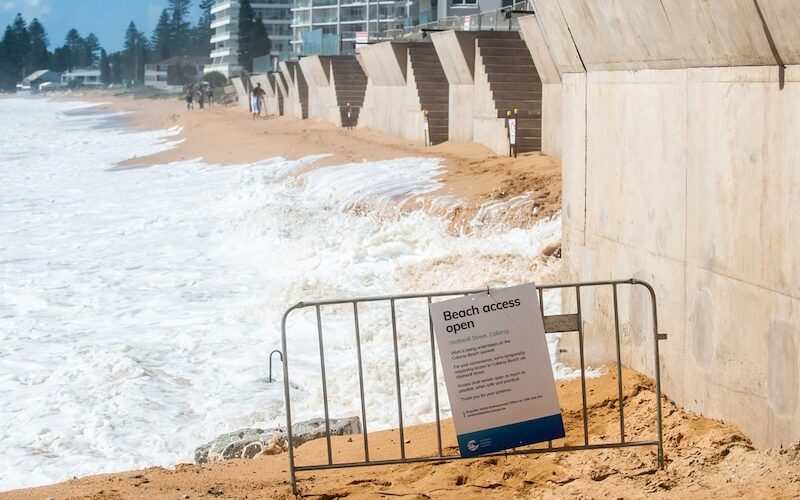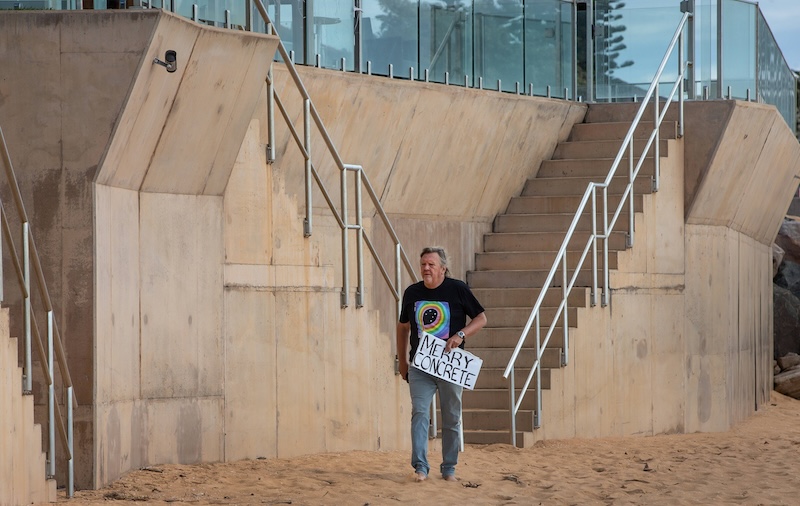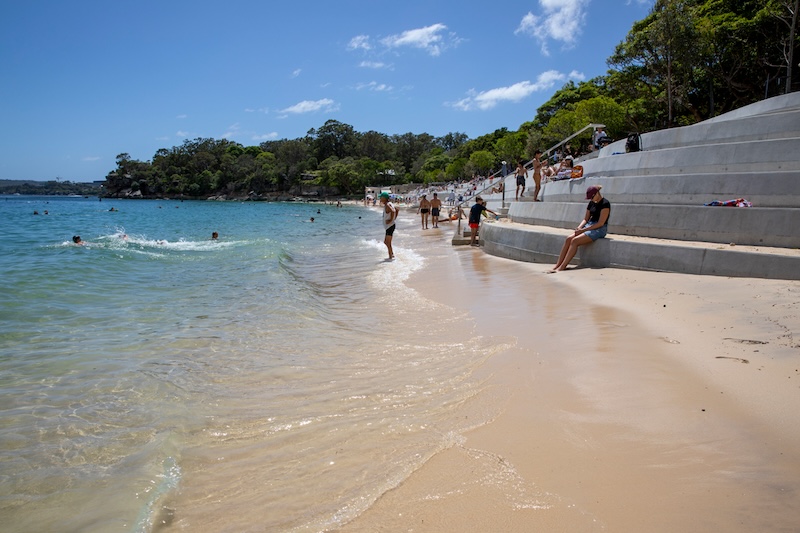Is pouring concrete a way of the rich getting richer? Vertical seawalls along the New South Wales coastline are extending the frontage of multi-million-dollar residential properties, while taking the beachfront away from the public. Marcus Reubenstein reports.
Post massive storm surges, and significant coastal erosion, in 2016 residents of Collaroy on Sydney’s northern beaches have been forced to endure a solution that many have dubbed the ugliest wall in Australia. A seven-metre-high vertical seawall has been erected along part of the beachfront between Collaroy and Narrabeen, the next beach north.
In addition to being an eyesore, it’s robbed locals of beachfront while enriching millionaire property owners by, in effect, substantially increasing the usable size of their properties.
The vertical concrete seawall has been erected at the original boundary of waterfront properties; in places, filling in land that was once a natural dune between the beach and the property. Now property owners are free to build pools and expansive grassed areas, leaving behind a public amenity boxed in by a massive concrete wall.
The justification for vertical seawalls is that they hold back tidal swells protecting the properties and the coastline. Says Angus Gordon, former general manager of the Pittwater Council on Sydney’s northern beaches, “These seawalls are a brutalist solution from the past century. Furthermore, because they have a shelf life, they simply don’t work.”
He points out that seawalls eventually fail, citing events at iconic Manly and Bondi beaches as examples.
A highly respected coastal engineer with more than 50 years of experience, Gordon says a far simpler and more practical solution is in wide use across the world and in particular Queensland’s Gold Coast.
“Rock revetments are the obvious and inexpensive solution to erosion and they have been successfully used at Collaroy to the south of the current vertical walls, he says.”
A revetment is a sloping installation of rocks that can absorb major storm events while preventing erosion. “The beauty,” according to Gordon, “is that sand blows up into the revetment, natural vegetation grows, and you’re left with what looks like a dune that doesn’t destroy the natural aesthetic of the waterfront but the underlying rock revetment is there to protect properties if a major storm event occurs.
“Furthermore, revetments can be altered and reinforced, whereas once you’ve built a vertical seawall that’s it.
“You wouldn’t know it, but much of the Gold Coast coastline is protected by a rock revetment buried under the sandy beach and dunes that have been artificially built by pumping sand from offshore onto the beach.”
While storm surges and beachfront sand erosion are still an issue on the Gold Coast there’s no proposals from any stakeholders to replace revetments with vertical seawalls.
New South Wales residents hoodwinked
A major issue says Brendan Donohoe, president of the Northern Beaches Branch of the Surfrider Foundation is that self-interest is behind the push for vertical seawalls. “For councils and state government it’s buck-passing as local property owners are footing much of the bill for the seawalls,” he says.
“But an individual landowner contributing $250,000 to the building of a vertical seawall gives them an immediate return on investment as at least that amount is added to the value of their property. It’s a solution of protecting private properties at the expense of community space.”
Aside from its mission to preserve coastline, the Surfrider Foundation is campaigning against what it says is conflicted advice, with a number of waterfront property owners presented with the vertical concrete seawalls as the only option to protect their properties from ocean surges.
At a meeting of owners of the Marquesas beachfront apartment complex in Narrabeen, recorded by one of the owners, a council officer was seen to be advocating for the construction of a vertical seawall. Aside from issues over its long-term effectiveness and impact on the beachfront landscape, it would also be a far more expensive option.
Says Donohoe, “Owners were apparently being told a vertical wall had to be constructed and they would have to pay for it. Various alternatives, including sand nourishment, were not put to them.”
Silencing dissenting voices
Following changes to New South Wales planning laws, the state government has effectively pawned off the decision-making process, leaving the hard choices to be made by councils.
Says Gordon, “Local councils have incredibly high staff turnovers and council officers cannot keep up with changes, they are too easily swayed by outdated coastal engineering thinking, nor do they have any idea of the history of the coastal areas they are responsible for.”
It seems that lack of knowledge has come to play with coastal protection works at Wamberal on the New South Wales Central Coast. There are plans to build three sections of vertical seawalls and Gordon had been appointed to the NSW Planning Department panel to review the proposals.
He was removed from the panel, being informed in writing that, “It has been raised with us that you may have had some previous involvement in this project including media comments and presentation of material to the Save our Sands group and may therefore have a reasonably perceived conflict of interest.”
In a written response, he hit back saying he had no conflict of interests, adding, “I believe this attempt to disqualify me is because I have been interested in coastal matters, including at Wamberal for 50 years. Hence, I have what could be seen to be an arguably unmatched knowledge of the issues at Wamberal and any proposal to undertake coastal works.”
According to Gordon the issue was most likely that the panel was giving consideration to a seawall and did not want a dissenting voice coming from a prominent coastal engineer who might advocate a far less costly solution with significantly lesser impact on the environmental landscape.
The Surfrider Foundation has written to the planning panel asking it to confirm rumours that Gordon will be replaced by an engineer who may have a conflict of interest in advising on the seawall approvals. Whilst the panel hasn’t responded a proposed preliminary meeting, at which Gordon was originally listed to attend, has been cancelled. Says Gordon, “I believe the panel has all but fallen over, the whole process has been compromised.”
More to come
In another baffling planning move, one of Sydney’s most iconic harbourside beaches has endured a two-and-a-half-year transformation that was billed as delivering Shark Beach at Nielsen Park an upgraded reinforced seawall. With cost and time blowouts, and the original engineering firm being sacked halfway into the project, the beach only reopened this month.
Now Shark Beach is missing one thing—a beach. At high tide the water is literally lapping at the base of the new seawall, beachgoers have been hived off onto concrete steps and a pristine piece of harbour foreshore has been destroyed.
With poor planning, conflicted stakeholders and a lack of proper oversight, says Gordon, “it’s concrete by stealth,” that has the potential to engulf significant areas of the state’s coastline.
Marcus Reubenstein is an independent journalist with more than twenty-five years of media experience. He spent five years at Seven News in Sydney and seven years at SBS World News where he was a senior correspondent. As a print journalist he has contributed business stories to most of Australia’s major news outlets. Internationally he has worked on assignments for CNN, Eurosport and the Olympic Games Broadcasting Service. He is the founder and editor of Asian business new website, APAC Business Review..





